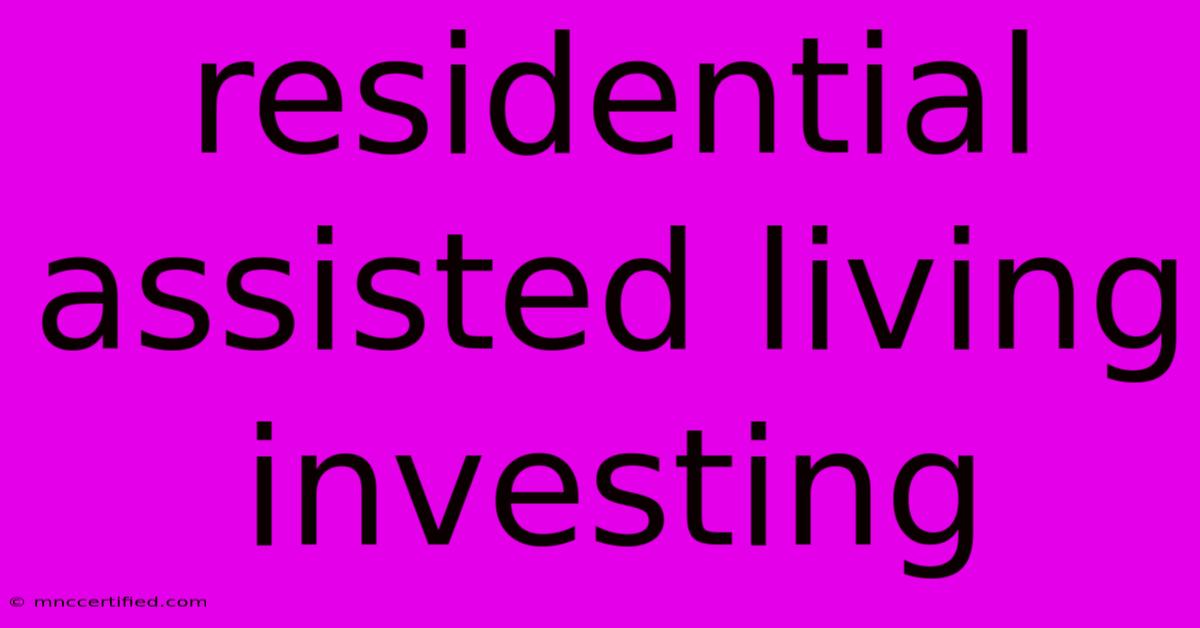Residential Assisted Living Investing

Table of Contents
Residential Assisted Living: A Lucrative Investment Opportunity
The demand for residential assisted living facilities (RALFs) is steadily increasing, fueled by the aging population and a growing preference for community-based care. This presents a unique opportunity for savvy investors seeking a profitable and socially responsible investment avenue.
Understanding the Assisted Living Market
Assisted living facilities cater to individuals who require help with daily tasks like bathing, dressing, and medication management, but do not need the intensive medical care provided by nursing homes. The growing elderly population, coupled with a shift towards personalized care, has propelled the assisted living sector into a high-demand market.
Here's why RALFs are attractive to investors:
- High Demand: The demand for assisted living is expected to continue growing, fueled by the aging baby boomer generation.
- Stable Revenue Streams: RALFs generate consistent revenue from residents' monthly fees, ensuring a predictable income stream.
- Low Vacancy Rates: The high demand and limited supply in many areas translate to consistently low vacancy rates, making RALF investments more secure.
- Potential for Appreciation: As the need for assisted living rises, the value of RALFs is likely to appreciate, offering investors a strong return on investment.
- Social Impact: Investing in RALFs contributes to a vital social service, providing high-quality care to seniors and their families.
Exploring Investment Options
There are several ways to invest in residential assisted living:
1. Direct Ownership: Purchasing and operating a RALF offers the potential for significant returns but requires substantial capital and hands-on management expertise.
2. REITs (Real Estate Investment Trusts): REITs specializing in senior living allow investors to own a stake in a portfolio of RALFs without the direct ownership burden.
3. Private Equity Funds: Investing in private equity funds focused on senior housing provides access to a diverse portfolio of RALFs with expert management.
4. Crowdfunding: Platforms like RealtyMogul or Fundrise allow investors to contribute to RALF development projects through fractional ownership.
Key Factors to Consider
Before diving into RALF investing, it's crucial to understand the following:
1. Market Research: Conduct thorough research on the local demographics and the demand for assisted living in your target area. 2. Regulation and Licensing: Ensure you comply with all state and local regulations regarding RALF operation and licensing. 3. Operational Costs: Factor in ongoing costs such as staffing, maintenance, and utilities. 4. Risk Management: Understand the potential risks associated with RALF ownership, including regulatory changes, competition, and fluctuations in resident occupancy.
Making the Right Decision
Investing in RALFs presents a unique opportunity for those seeking a financially rewarding and socially impactful venture. By conducting thorough research, understanding the market dynamics, and choosing the right investment strategy, you can capitalize on the burgeoning senior care market and contribute to a growing need within your community.

Thank you for visiting our website wich cover about Residential Assisted Living Investing. We hope the information provided has been useful to you. Feel free to contact us if you have any questions or need further assistance. See you next time and dont miss to bookmark.
Featured Posts
-
Does Insurance Pay For A Nutritionist
Nov 10, 2024
-
Siskiyou Insurance Grants Pass Oregon
Nov 10, 2024
-
Nba Clippers Vs Warriors Key Players To Watch
Nov 10, 2024
-
Bodie Kane And Marcus Investments Pdf
Nov 10, 2024
-
Pokemon Trading Card Game 2 Japan Rom
Nov 10, 2024